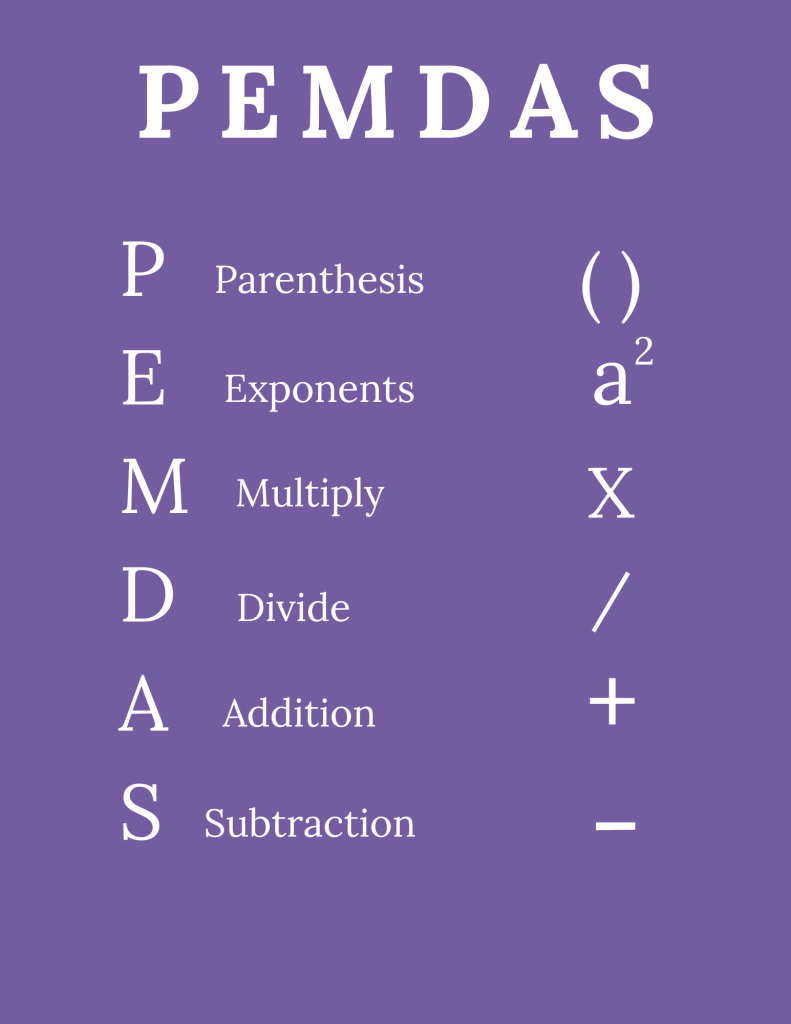Understanding PEMDAS: The Order of Operations in Mathematics
Table of Contents
Introduction
PEMDAS
In the realm of mathematics, the acronym PEMDAS holds significant importance, serving as a fundamental principle in the order of operations. Let’s delve into the concept of PEMDAS and explore its relevance in solving mathematical equations and expressions.
Analogy of Definition
What is PEMDAS?
PEMDAS, which stands for Parentheses, Exponents, Multiplication, Division, Addition, and Subtraction, represents the sequence of operations to be followed when evaluating mathematical expressions. It provides a systematic approach to ensure accurate and consistent results.
Method
Implementing PEMDAS
When faced with a mathematical expression, the principles of PEMDAS guide individuals to first evaluate operations within parentheses, followed by exponents, multiplication, division, addition, and subtraction, in that order.

P: Parentheses
Parentheses (or brackets) are used to group parts of an expression. Operations inside parentheses should be performed first.
Example:
(3 + 2) × 5
First, solve the operation inside the parentheses: 3 + 2 = 5
Then, multiply by 5: 5 × 5 = 25
E: Exponents
Exponents indicate that a number is to be multiplied by itself a certain number of times.
Example:
23 + 4
First, calculate the exponent:
23 = 2×2×2 = 8
Then, add 4:
8 + 4 = 12
M: Multiplication
Multiplication should be performed after parentheses and exponents but before addition and subtraction.
Example:
4 × 3 + 2
First, perform the multiplication:
4 × 3 = 12
Then, add 2:
12 + 2 = 14
D: Division
Division should be performed after parentheses and exponents but before addition and subtraction. It is evaluated from left to right, just like multiplication.
Example:
20 ÷ 4 + 3
First, perform the division:
20 ÷ 4 = 5
Then, add 3:
5 + 3 = 8
A: Addition
Addition should be performed after parentheses, exponents, multiplication, and division. It is evaluated from left to right, just like subtraction.
Example:
5 + 3 – 2
First, perform the addition:
5 + 3 = 8
Then, subtract 2:
8 − 2 = 6
S: Subtraction
Subtraction should be performed after parentheses, exponents, multiplication, and division. It is evaluated from left to right, just like addition.
Examples
Example 1: To solve an expression using PEMDAS, follow the order:
- Parentheses
- Exponents
- Multiplication and Division (left to right)
- Addition and Subtraction (left to right)
Example:
Solve 3 + 6 × (5 + 4) ÷ 32 – 1
Parentheses: 3 + 6 × 9 ÷ 32 – 1
Exponents: 3 + 6 × 9 ÷ 9 – 1
Multiplication and Division (left to right):
-
- First, 6 × 9 = 54
- Then, 54 ÷ 9 = 6
- Result: 3 + 6 – 1
Addition and Subtraction (left to right):
-
-
- First, 3 + 6 = 9
- Then, 9 – 1 = 8
-
Final answer: 8
Quiz
Tips and Tricks
1. Use a Mnemonic Phrase
Tip: Use the phrase “Please Excuse My Dear Aunt Sally”. Each word corresponds to a step in the order of operations:
-
- P: Parentheses
- E: Exponents
- M: Multiplication
- D: Division
- A: Addition
- S: Subtraction
2. Visualize the Steps
Tip: Draw a staircase or pyramid with each step labeled from top to bottom:
-
- Top: Parentheses
- Next: Exponents
- Next: Multiplication/Division
- Bottom: Addition/Subtraction
3. Use Parentheses to Simplify
Tip: When in doubt, use extra parentheses to group numbers and operations. This can make complex problems easier to manage and ensure you perform operations in the correct order. Example: Instead of solving 3 + 6 × 2, rewrite it as 3 + ( 6 × 2 ).
4. Left to Right for Multiplication/Division and Addition/Subtraction
Tip: Remember that multiplication and division are performed from left to right, as are addition and subtraction. If both operations are present, simply go from left to right. Example: In 8 ÷ 2 × 4, divide first: 8 ÷ 2 =4, then multiply: 4 × 4 = 16.
5. Practice with Simple Examples
Tip: Regular practice with simple examples helps reinforce the order of operations.
Real life application
Scenario: Budgeting for Expenses
When managing finances, individuals often encounter the need to calculate expenses and allocate funds. By applying the principles of PEMDAS, they can accurately prioritize and evaluate financial obligations, ensuring effective budgeting and financial planning.
Scenario: Recipe Measurements
In culinary endeavors, precise measurements are essential for creating delectable dishes. The principles of PEMDAS enable individuals to calculate ingredient quantities accurately, ensuring the success of recipes and culinary creations.
Scenario: Distance Calculations
Whether planning a road trip or determining travel distances, understanding PEMDAS allows individuals to calculate distances and travel times with precision, facilitating efficient travel planning and navigation.
FAQ's
Like? Share it with your friends






